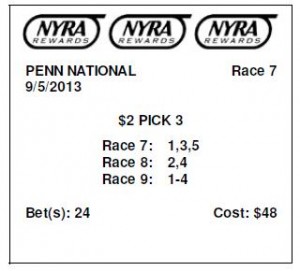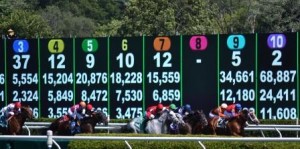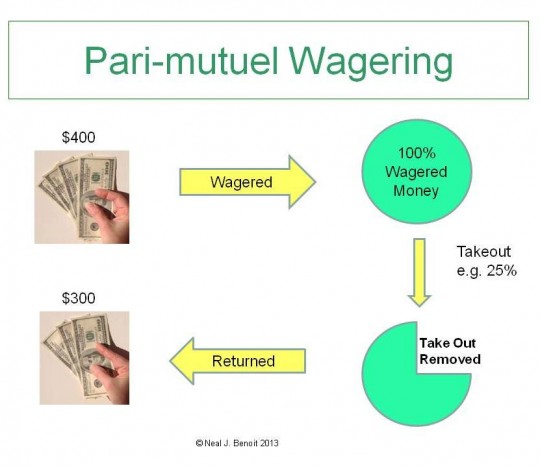Sep 24
2018

Nancy Meyers
Introduction (by Neal Benoit): The following is a story about a 2018 Travers Stakes score by our guest author, Nancy Meyers. FYI, the order of finish was Catholic Boy (7-1), Mendelssohn (13-1), Bravazo (10-1), King Zachary (28-1). The $1 exacta paid $145, 50-cent triple paid $744, and 10-cent Superfecta paid $1,796.
By Guest Author: Nancy Meyers
Neal has asked that I take on the topic of “collaborative handicapping”, in response to my recent success wagering on the 2018 Travers.
My definition of “collaborative handicapping” means that you draw information from multiple sources and other people’s opinions which exceed personal review of the PPs and other statistical data. When I look back at my process I found I initially used a lot of the techniques listed in my prior article, The Casual Handicapper.
First, I got the PPs from Equibase and spent some time Friday evening perusing the card and trying to plan wagers over the course of about 10 races so that I was sure to have some cash available to wager on the Travers.
In my initial review, I identified 3 horses of interest: Tenfold, Mendelssohn and Catholic Boy.
Tenfold was intriguing because of the effort he displayed in the Preakness. Asmussen and Santana have had a pretty strong Saratoga meet and I hated to have them knock me out of a big score.
Read More >>
Jun 5
2018
I chose the term “surviving” with intent. Whether Belmont Stakes, Kentucky Derby, Travers Stakes, or Breeders’ Cup Day … all of these “event days” have one thing in common – they are marathons with a dozen races or more that start in the morning and end past suppertime. Even for the most experienced horseplayers, event days test your endurance in ways that an ordinary day at the track does not.
On more than one occasion, I have found myself completely “out of gas” before the main event even took place. For this reason, I have been refining an approach that is intended to help me (and you) make it through these days intact. First, let me say, some of the strategies I am going to suggest are ones I would not necessarily use on normal race days. The reason for this is simple, the challenges you face on “event” days are formidable and they require adaptations that will help you deal with them. Among the many challenges are the following: Read More >>
Aug 4
2015

On Xpressbet.com there is a tournament called Dime-a-Day. It is offered for two race tracks (Del Mar and Saratoga) during the summer months. There is no registration fee, but you have to register and be a member of Xpressbet. After registration, you make “live” wagers of $10 per day on a single Win, Place, or Show bet. Live meaning the money you are betting is real money from your account, not mythical money as in some tournaments. Of course that also means that if your bet wins, you get the money added to your account regardless of what happens in the tournament.
The format is fairly simple. Each racing day you place a single contest wager of $10 to Win, Place, or Show on a any horse in any race. At the end of the day Xpressbet awards $1,000 in prize money to the person(s) who won the most money with their $10 wager. In the event of a tie, the prize money is evenly distributed to the winning players for each position. The top three payoffs for daily prizes is the following:
| Position |
Daily Prize Money |
| 1st |
$700 |
| 2nd |
$200 |
| 3rd |
$100 |
At the end of the season additional prize money is distributed to competitors with the most cumulative contest earnings over the course of the entire season. The top three seasonal prizes are:
| Position |
Season Prize Money |
| 1st |
$6,000 |
| 2nd |
$3,000 |
| 3rd |
$1,000 |
I have played in this tournament the past three years at Saratoga, and have shared in the prize money multiple times. Even if I didn’t, I still would have enjoyed the experience. Read More >>
Jan 13
2015
One of the tricks to successful wagering is making the right wagers in the right situations … and recognizing the situation when it appears. After handicapping a race, a number of scenarios can unfold. When you’re new to horse racing, it seems like these scenarios are countless. But, after doing it awhile, you start to see patterns emerge.

One pattern I’ve discovered is what I call the “High and Low” scenario. High is a identifying a horse that you feel confident is a serious win threat, but isn’t an optimal Win play. Maybe his odds are too short, or you already have him covered in a Double, Pick-3, or Pick-4 wager. Low is marking a horse that you feel doesn’t have much chance of winning, but has a legitimate shot of finishing in the “lower rungs” of an exotic wager (like a Superfecta). Lower rungs for a Superfecta would be 3rd or 4th place. An added attraction to this play is when your Low horse is long in odds and/or the rest of the field is a wide-open affair (the combination of the two is ideal).
Read More >>
Nov 28
2014

The mathematics for computing the cost of Pick-3, Pick-4, Pick-5, and even Pick-6 tickets is actually fairly simple. The more complicated task is determining which horses you are going to include on these tickets and in what dollar increment you are going to make your wagers. Also, in the case of Pick-3 wagers, determining which sequence of three races is optimal for making a wager. Most tracks offer “rolling” Pick-3 wagers, meaning that you can start a Pick-3 on any race, as long as there are two more races following that race.
However, Pick-4, Pick-5, and Pick-6 opportunities exist only on a specific sequence of races that is determined by the race track. For example, many tracks offer an early Pick-4, a late Pick-4, and a single Pick-5 and/or Pick-6. If there are ten races, the early Pick-4 might be on races 2 through 5, the late Pick-4 on races 7 through 10, and a Pick-6 on races 5 through 10. You have to look at the program to determine exactly what wagers are available on each race.
Read More >>
Sep 9
2014

Most major racetracks in North America now offer a minimum Trifecta wager of only 50-cents. This lower minimum wager enables bettors to construct tickets that cover more horses and keep the cost of the tickets affordable. With this in mind, we’re going to introduce a Trifecta wagering strategy we call the “Sandwich Play.” Read More >>
May 5
2014

A 2-1 Favorite On The Board
About 24 hours before the 2014 Kentucky Derby I received an e-mail from an old horse racing buddy that said, “I need to bet an Oaks-Derby Double. Do you think Untapable is unbeatable? And, can you give me some horses and thoughts on the Derby?”
Regarding Untapable in the Kentucky Oaks, I replied that she had to overcome the outside post position, but I felt she had enough tactical speed to do that. She has the best Beyer Speed Figures in the field, by far, and in her last race Rosie was peeking back in mid-stretch. I wrote in my trip notes “done with ease.” Untapable was solid, albeit a heavy favorite at 1-1 on the tote board.
Regarding the Kentucky Derby, I replied:
- California Chrome (#5) has just looked so darn impressive visually. He seems like the real deal.
- Have to use Danza (#4) after the way he finished in the Arkansas Derby.
- Can’t argue with Wicked Strong (#20). It appears he just didn’t like Gulfstream Park.
I ended my reply with, “I know that’s kind of boring, but I’m starting to get the feeling that the logical horses might prevail this year.”
Read More >>
Apr 20
2014
The system of betting that is standard throughout the horse racing world is based on pari-mutuel wagering. All money wagered is placed into a pool, a “Take-Out” is removed from the pool, and the remaining money is returned to the winning wagers. The diagram below shows an example with the assumption of a 25% takeout rate and a total of $400 wagered.

Read More >>
Mar 11
2014
The following story was contributed by my horseplayer friend, Vince The Volcano.

A regular horseplayer has many ups and downs in this game and each person’s individual personality determines which of these swings you remember the most. For me, it’s the losing stories that I remember fondly. Seriously, who wants to hear a person tell you they’re winning all the time? I love hearing the stories that we horseplayers can relate to. It makes us feel better about ourselves because as you listen to another’s tale you can’t help but think, “I’m not the only one.”
One of my favorite stories occurred in my early years of horse playing and I remember it like it was yesterday. It was October of 1989 and I was fresh out of college. It was the days of no wives, kids or any responsibilities. On this particular Saturday in October there was a group of eight of us hunkered down in someone’s living room with cases of beer and multiple TV’s setup to enjoy a day of college football (ah to be young again). What the group didn’t know was that I was about to sell them on the ride of a lifetime, by making a serious run at a Pick-6, the most elusive bet in horse racing.
Read More >>
Feb 19
2014

In a prior article, we explained the concept of Boxing Bets, and in particular Boxing Exacta and Trifecta Wagers. In this article we will explain why we think Weighted Wagers is a better approach and should be used with the majority of Exacta and Trifecta wagers, especially when you feel the horses have disparate chances of winning.
Boxing wagers assumes that each horse has an equivalent chance of winning. And, maybe after handicapping a race, that is exactly how you feel. If that’s the case, then by all means make a “Box” wager. But, often you have a preference for one horse, over another, possibly over another. In that case, if you’re handicapping is good … shouldn’t you be rewarded appropriately if your opinion turns out to be correct?
Read More >>








